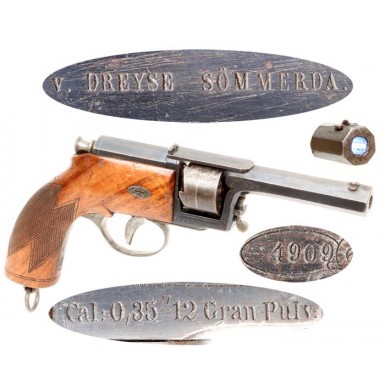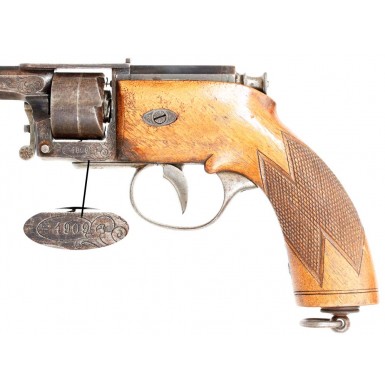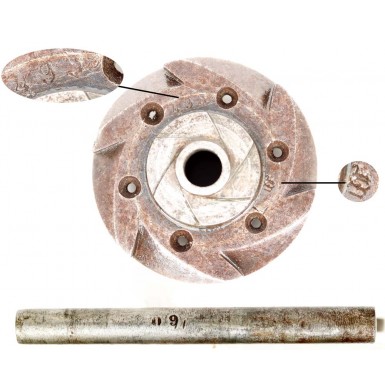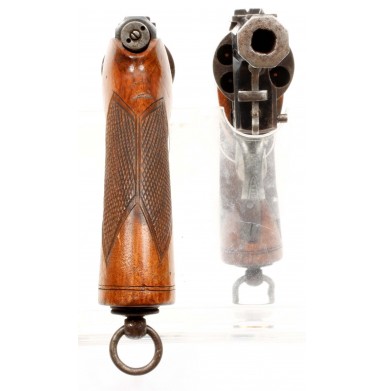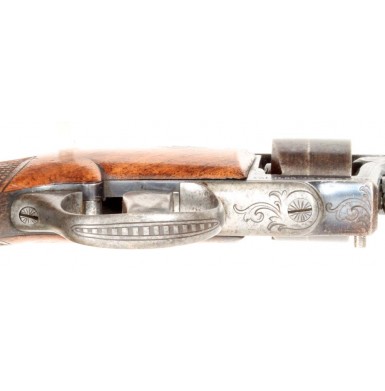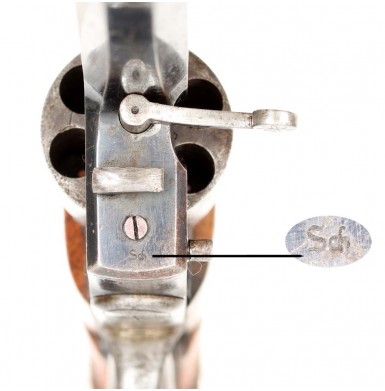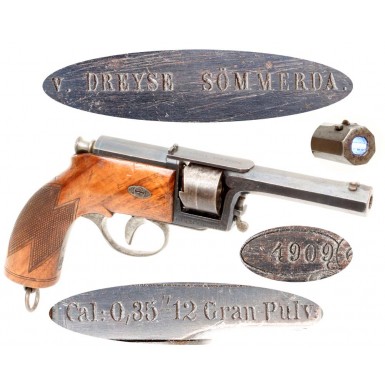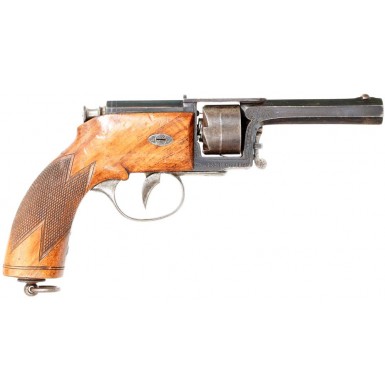Johann Nikolaus Dreyse (later Nikoluas von Dreyse) was born in SŒMMERDA, a town in the German state of Thuringia in 1787. The son of a lock maker, Johann Nikolaus Dreyse was apparently mechanically inclined and was apprenticed as a gunsmith. By the age of 22 Dreyse was working in Paris for the famous Swiss gunsmith and firearms designer Jean-Samuel Pauly. Dreyse worked for Pauly from 1809 to 1814, and was in Pauly’s employ while the Swiss inventor worked on a design for a practical breechloading military rifle that utilized a self-contained cartridge. Pauly had developed the formula for fulminate of mercury, a primary explosive agent that would become the basis for percussion cap and self-contained cartridge ignition. In 1808, while working with French gun maker François Prélate, Pauly developed the first self-contained cartridges, utilizing a potassium chlorate primer powder, a fulminate of mercury ignition system, a and a bullet, all contained in a casing of either brass or paper. The ignition contact was made by the first successful modern “firing pin”, which was a long needle that penetrated the cartridge and ignited the priming compound at the base of the bullet. With this invention, the world had been introduced to both the self-contained cartridge and the needle fire system. On April 5, 1814 the Allied forces lead by Great Britain took Paris and with Napoleon’s abdication 6 days later the era of First Empire came to a close. With the fall of Paris Pauly escaped to London, where he continued to work on firearms designs, primarily in association with the London gunmaker Durs Egg. Dreyse returned to SŒMMERDA where Pauly’s influence clearly directed his thoughts and designs. In 1824 Dreyse opened a factory in SŒMMERDA to manufacture percussion caps, based upon Pauly’s formula for fulminate of mercury. However, in addition to making percussion caps, Dreyse continued to try to improve upon Pauly’s needle fire concept, developing a muzzleloading needle fire rifle in 1827 and breechloading version in 1836. The new design was a bolt action, breech loading rifle, that used a long “needle” like firing pin to pierce the self-contained paper cartridge and ignite the “percussion cap” at the base of the bullet, using the bullet as the anvil upon which the primer was struck. The fact that the rifle was a bolt operated breechloader offered significant advantages over the conventional muzzleloading arms of the day. It allowed a much greater rate of fire than a muzzleloader and allowed the user to easily load the gun while prone or in other positions that were not conducive to the use of a muzzleloading long arm. The Prussian military saw the great potential of such a weapon, particularly when used against an opponent with conventional muzzleloader and in 1841 adopted Dreyse’s design as the Leichtes Perscussions-Gewehr Model 1841 (light percussion rifle Model 1841), a name chosen to help conceal the radical technology of the design. Eventually the secret was revealed to the world and a variety of Prussian Zündnadelgewehr (needle-gun) models would be utilized by the Prussian military for some three decades until the adoption of the Mauser M1871 rifle. While the Dreyse design certainly had its military advantages, it had some technological disadvantages as well. The action of the rifle did not offer any form of obturation (gas seal) other than the cartridge itself, so the action leaked gas when it was fired and this also reduced the velocity and overall effective range of the bullet. The ignition design also meant that the long needle firing pin was inside the cartridge when it detonated, causing the corrosive fulminate of mercury priming compound and the hot gasses from the exploding cartridge to corrode and weaken the needle, eventually causing it to break after an average of about two dozen rounds had been fired. Despite these disadvantages, the rapid rate of fire of the guns in the hands of the well trained Prussian troops allowed the Dreyse design to dominate European battlefields for more than two decades. With the adoption of the M1841, Dreyse expanded his SŒMMERDA factory to produce needle rifles for military service as well as a line civilian needle rifles and handguns. Initially the handguns were single shot affairs, but sometime around 1860 Dreyse introduced a needle fire revolver to his product line. The design had been patented by George L. Kufahl in Great Britain on March 3, 1852 (British Patent #13994, 1852), but had not been well received and no British makers seemed inclined to produce a revolver based upon Kufahl’s design. Kufahl’s patent would only be in effect for fourteen years (expiring on March 3, 1866), so it appears that he approached Dreyse sometime around 1860 to produce his revolver design under license in order to monetize his invention. The Dreyse manufactory in SŒMMERDA would eventually produce between 11,000 and 12,000 of these unique, needle fire revolvers over the course of about two decades. The the estimated production numbers are based upon known surviving examples serial numbered in the low 11,XXX range. The guns appear to have been produced in three basic models, all essentially identical in action and design and varying only in overall size and caliber. All of the guns were self-cocking revolvers with needle fire ignition systems. Today, we would refer to these guns as having double action only lock works and being striker fired. The guns were available in three basic bore sizes, much like most percussion revolvers of the period being offered in “pocket”, “belt” and “holster” models. The guns were offered in approximately .30 caliber with a 3 ““ barrel, in .38 caliber with a 4” barrel and in .43 caliber with a 4 ““ barrel. I say “approximately” as the caliber of the guns was measured in a Prussian variant of inches, the Zoll (pre-metric system) that is about 8% larger than the English inch. The Zoll varied across the German states, being anywhere from 1/10 to 1/12 of a foot, and the length of a foot varied in the German states as well, being as short as about 9 ““ in some locations and as long as 17 1/8” in others! Thus, one of these revolvers marked “35 cal” would actually measure about .38”. The guns all had a distinctive elongated frame profile with a significant amount of the revolver behind the cylinder. This was necessary to allow enough room for the long needle to be housed and to allow enough range of motion for the cocking action of the needle. The barrels were all octagonal in cross section with swamped profile, expanding slightly at the muzzle and were rifled with four grooves about the same width as the lands and a rather slow rate of twist. The cylinders were loaded from the front and only had a small hole in the rear face through which the needle could pass to detonate the cartridge. The cylinder design was more akin to the various patent front loading cartridge designs found in American revolvers of the era from makers like Moore. The large, slightly humpbacked, checkered walnut grip enclosed the lower portion of the frame and action on both sides. The barrels and cylinders of the revolvers were blued, with the triggerguards were case hardened. A small stud for a removable, non-attached loading lever was mounted on the left side of the lower front edge of the frame. This is similar to the design used on the 1st Model Tranter “double trigger” revolvers. A handful of the Dreyse/Kufahl revolvers are known with attached loading levers, but these are very rare exception and not the rule. The removable lever was probably intended to be stored in a casing for the revolvers with other accessories and they are rarely encountered. The guns included a fixed lanyard ring on the bottom of the buttcap. The revolvers are often found with simple engraved motifs, typically foliate and geometric. The guns were serial numbered on the lower left side of the frame, and the full serial number is also typically found on the rear of the cylinder, on the lower left angled flat of the needle housing (concealed by the grip) and inside the backstrap inlet of the grip. The loading lever, when present and numbered, should bear the full serial number as well. The cylinder arbor pin typically bears only the last two digits of the serial number. The right side of the frame, below the cylinder is typically marked with the caliber (in Prussian inches) and with the powder charge for the cartridge, either in “cent” ( a Prussian unit of measurement) or the more conventional method of measuring gunpowder weight, grains. The topstrap is typically marked with the Dreyse name and the location of the factory, SŒMMERDA. As no serial number records are available to date the production of these firearms, the topstrap marking can help bracket the dates during which the gun was likely manufactured. Nikolaus Dreyse (he dropped the Johann sometime after his return to SŒMMERDA in 1814) was knighted by the Prussian king in 1864, allowing him to add the honorific title “von” to his last name. As such, guns produced by Dreyse prior to 1864 are simply marked with that name, while those produced after the knighting are marked “v. Dreyse”, indicating his new title. Nikolaus von Dreyse died on December 9, 1867 and after his death the company was taken over by his son Franz von Dreyse (bestowed titles were hereditary and were passed down unless they were revoked). Sometime not long after his father’s death, Franz changed the markings on the guns from “v. Dreyse” to “F v. Dreyse”. Thus, a gun without the “v” was made prior to the knighting in 1864, those with the “v” but not marked with an “F” are from circa 1864-1868 and those with the “F” are post the death of Nikolaus in early December of 1867. Another indicator of production time frame is the use of the Zoll or Cent to measure size or weight on the frame of the gun. The metric system became the mandatory system of measurement in Imperial Germany on January 1, 1872, thus eliminating the old systems of measurement. Any Dreyse gun marked with the archaic units was produced prior to the adoption of the metric system. While the large majority of the Dreyse/Kufahl revolvers were sold commercially, a small number of the large caliber guns were acquired by secondary military units like border guards and by some police departments. These guns were typically bear Prussian military inspection marks and proofs in addition to the normal commercial marks, and will sometimes be found with unit marks as well. While the production figures of slightly more than 11,000 guns suggest that these revolvers should appear on the market with some regularity, they are actually exceptionally scarce. This can be explained by two primary reasons. First, the delicate needle often broke and without a replacement the gun was useless. Secondly the needle fire design was very quickly rendered obsolete by self-contained metallic cartridges, again making the guns almost useless. These two factors combined to make the guns prime candidates for the scrap metal drives held in Germany during two world wars, where old and obsolete items were converted into newly made weapons of war like tanks and airplanes. As a result these revolvers are exceptionally scarce today, especially in working condition and with an original, full length needle.
This Dreyse/Kufahl Needle Fire Revolver is in VERY FINE condition. The gun is 100% complete, correct and original, with the exception of the removable loading lever which is not present (and practically never is). The gun is mechanically EXCELLENT and retains its original, full-length and fully functional needle. The revolver is clearly mark on the topstrap: v. DREYSE SŒMMERDA . , indicating that Dreyse produced this revolver at his SŒMMERDA factory after his knighthood in 1864, but prior to his death when Franz added the “F” before the “v” in the barrel mark. The lower left side of the frame is marked with the serial number 4909 and this complete number is found on the rear face of the cylinder, on the needle housing (under the large wooden grip) and inside the backstrap cut out of the grip. The matching mating number 09 (the last two digits of the serial number) is found on the cylinder arbor pin. The lower right side of the frame is marked in a single line:
Cal: 0,35” “ 12 Gran Pulv.
This indicates that the gun is .35 caliber (measured in Zoll) and the cartridge charge is 12 grains of powder. Measuring the bore with calipers reveals it is about .353” land to land (about 8.98mm) and .376” groove to groove (about 9.57mm), so the gun is nominally the equivalent caliber to a modern “.38” (typically .357”) or 9mm (about .355”-.356”). The 12 grain powder charge seems a little light, but obviously the gun was designed for relatively close work and not long distance shooting. The only other marks on the gun are the Gothic letters Sch which is probably a factory inspection mark or trademark, as the proving of commercial firearms in Prussia was not required during the time these guns were manufactured. The gun is lightly engraved throughout, with simple foliate scrolls present on the frame and rear of the barrel, and front of the triggerguard. The bottom of the triggerguard features simple geometric designs and stars are incorporated into the design on the forward portion of the right side of the frame. The head of the cylinder pin and the grip screw escutcheons have simple floral petals engraved on them and the heads of the grip and triggerguard screws are engraved with simple lines. The revolver is about 11 ““ in overall length with a slightly swamped 4” octagonal barrel that increases from .733” thick at the frame to .783” at the slightly flared muzzle. The rear sight is a simple fixed, notched block on the rear of the topstrap, and the front sight blade is mounted in a dovetail and drift adjustable for windage. The flat butt contains a fixed, non-swiveling iron lanyard ring. The revolver retains about 70%+ of its original blued finish overall, mostly on the barrel and the frame, which probably retain about 80%+ of their blue. These areas shows some thinning and fading of the finish and some loss along the high edges and contact point. The areas where the finish has worn have a mostly dull pewter gray patina. The cylinder retains only about 20%+ original blue, with significant loss to fading and wear, with the balance of the metal having a mostly smooth plum brown patina that blends well with the remnants of the bright blue. The lanyard ring and mount in the base of the grip have a mostly brownish, lightly oxidized patina and the case hardened triggerguard has a smoky gray patina with no obvious case coloring remaining. The face of the muzzle, the wide trigger and the needle mechanism all appear to have been left in the white and were originally polished bright, but have now toned down and have an attractive steel gray patina. The metal of the gun is mostly smooth, with some lightly scattered pinpricking on the frame, mostly around the cylinder mouths. The muzzle shows some minor surface oxidation as does the gripstrap. Some lightly oxidized freckling is also present, scattered over the entire gun and mixed with the remaining original blued finish. The revolver is mechanically excellent, and even though the striker fired, double action only mechanism is not conducive to light trigger pull, the extra wide trigger and well executed lockwork make the trigger pull quite smooth and very comfortable, comparable to very high quality modern revolver. The bore of the revolver is in about VERY GOOD condition. It is mostly bright with crisp, deep rifling its entire length. There is some scattered light pitting along the length of the bore with a couple of more moderate areas of pitting as well. The bore might be improved by a good scrubbing with a bronze brush. The large, one-piece wood grip is in VERY FINE condition as well. The grip is solid, complete and free of any breaks, cracks or repairs. The deep diamond pattern checkering remains very crisp through the entire grip area with only some minor surface wear and slightly dulling to the points of the checkering. The grip retains the large majority of what appears to be its original varnished finish. The grip does show scattered minor bumps, dings and impact marks typical of a 19th century revolver that was actually carried and used during its lifetime, but shows not abuse or real damage.
Overall this is a really fantastic example of a very scarce and very high condition Dreyse/Kufahl Needle Fire Revolver. The gun is 100% original with all matching numbers, is fully functional and retains its original, full-length needle. These guns rarely appear for sale in complete condition, and typically when they are found they either have mismatched serial numbers or the needle is broken (or missing). This gun has none of those problems and still retains the large majority of its original finish, even though it shows clear signs of real period use as well. Based upon recent sales of these revolvers at major US auction houses, similar condition guns with broken needles are selling in the $6,000-$7,000 range, and at least one major US dealer is offering one with mismatched numbers for more than $8,000! This is a very reasonably priced example of a very scarce Dreyse/Kufahl Needle Fire Revolver that was produced sometime between mid-1864 and early 1868, and it would be a wonderful addition to any serious collection of early cartridge revolvers, Dreyse guns, needle guns or 19th century German firearms. The unique profile and nice condition will certainly make it stand out in your collection.
SOLD
